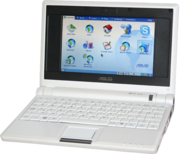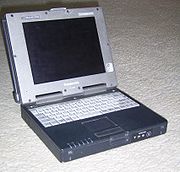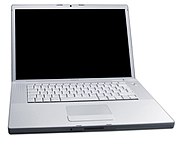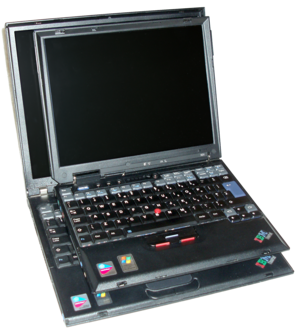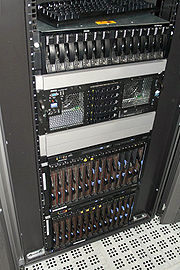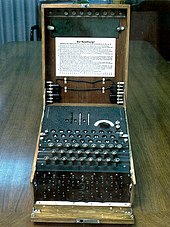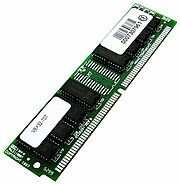Other portable computing devices
There are several categories of portable computing devices that can run on batteries but are not usually classified as laptops: portable computers, keyboardless tablet PCs, Internet tablets, PDAs, handheld computers (UMPCs) and smartphones.
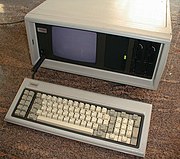




A Portable computer is a general-purpose computer that can be easily moved from place to place, but cannot be used while in transit, usually because it requires some "setting-up" and an AC power source. The most famous example is the Osborne 1. Also called a "transportable" or a "luggable" PC.
A Tablet PC that lacks a keyboard (also known as a non-convertible Tablet PC) is shaped like slate or a paper notebook, features a touchscreen with a stylus and handwriting recognition software. Tablets may not be best suited for applications requiring a physical keyboard for typing, but are otherwise capable of carrying out most tasks that an ordinary laptop would be able to perform.
An Internet tablet is an Internet appliance in tablet form. Unlike a Tablet PC, an Internet tablet does not have much computing power and its applications suite is limited - it can not replace a general purpose computer. Internet tablets typically feature an MP3 and video player, a web browser, a chat application and a picture viewer.
A Personal digital assistant (PDA) is a small, usually pocket-sized, computer with limited functionality. It is intended to supplement and to synchronize with a desktop computer, giving access to contacts, address book, notes, e-mail and other features.
A Handheld computer, also known as an Ultra Mobile PC (UMPC) is a full-featured, PDA-sized computer running a general-purpose operating system.
A Smart phone is a PDA with an integrated cellphone functionality. Current smartphones have a wide range of features and installable applications.
Boundaries that separate these categories are blurry at times. For example, the OQO UMPC is also a PDA-sized tablet PC; the Apple eMate had the clamshell form factor of a laptop, but ran PDA software. The HP Omnibook line of laptops included some devices small enough to be called handheld computers. The hardware of the Nokia 770 internet tablet is essentially the same as that of a PDA such as the Zaurus 6000; the only reason it's not called a PDA is that it doesn't have PIM software. On the other hand, both the 770 and the Zaurus can run some desktop Linux software, usually with modifications.
[edit] Major brands and manufacturers
| There is a multitude of laptop brands and manufacturers; several major brands, offering notebooks in various classes, are listed in the box to the right. The major brands usually offer good service and support, including well-executed documentation and driver downloads that will remain available for many years after a particular laptop model is no longer produced. Capitalizing on service, support and brand image, laptops from major brands are more expensive than laptops by smaller brands and ODMs. Some brands are specializing in a particular class of laptops, such as gaming laptops (Alienware), netbooks (EeePC) and laptops for children (OLPC). Many brands, including the major ones, do not design and do not manufacture their laptops. Instead, a small number of Original Design Manufacturers (ODMs) design new models of laptops, and the brands choose the models to be included in their lineup. In 2006, 7 major ODMs manufactured 7 of every 10 laptops in the world, with the largest one (Quanta Computer) having 30% world market share.[41] Therefore, there often are identical models available both from a major label and from a low-profile ODM in-house brand. |

